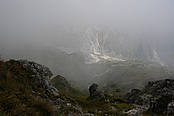The dawn of mountaineering
From scientific mountaineering to exploration-sport After the border police, came the topographers and more generally, the experts. But only after a long time. In fact, it was only in 1817 when the Austrian Government made the first trigonometric surveys, where it was necessary to reach the summits, and the first topographic maps were drawn up. Following this, for exclusively scientific purposes, came the botanists, the zoologists, the geologists, the meteorologists and the geographers. Then, finally, the mountain climbers. nevertheless, the highest summit of the Julian Alps, the Tricorno, had already been climbed in 1778 by Willonitzer with three friends; we then have news of a traveller, who in 1784 writes about his first climb on Mount Tricorno, Balthasar Hacquet. And, again Dr. Otto Sendtner from Munich, an alpine climber and botanist, who, between 1841 and 1843 , by order of the Triest State Councillor, Muzio de Tomasini, collected and classified the first examples of the local alpine flora. Among one of the most significant figures of mountain climbing in the area is Giuseppe Pesamosca called "il Louf" (the wolf). Explorations and climbs were accomplished by the Friulan Marinelli, Hoche, and di Brazzà in the eastern Julian Alps, and by others in the western Alps. Findenegg, a chemist from Villach, managed to climb the Ursic and Canin from the north and, in 1877, was the first climber of the Montasio along the canal, which was then named after him.







